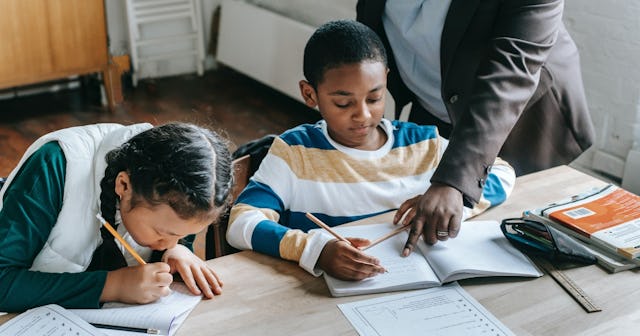What Is Classroom Management, And How Can You Apply It At Home?

As a parent, you’re very familiar with how challenging — and exhausting — it can be to keep even one or two kids safe and occupied for hours at a time. And yet somehow, teachers manage to do this five days a week most of the year, for extended periods of time. Willingly. This is just one of the many reasons why we think teachers are rock stars. While it can be difficult to imagine how that’s even humanly possible, it does help to know that teachers go through years of dedicated training to learn about effective classroom management. (Unlike in Laura Ingalls Wilder’s time, when a girl turning 16 and being good in school were the main qualifications required to teach and supervise an entire classroom of her peers.)
Whether or not parents realize it, a large part of their job does involve some sort of teaching. And even if they don’t have a degree in education, that doesn’t mean they can’t borrow some strategies from great teachers. Here’s what parents should know about classroom management, including techniques, plans, and more.
Classroom Management Definition
If classroom management sounds like serious business, that’s because it is. When you’re only one person (or maybe two or three, if there are aides) up against a roomful of children of varying academic levels, attention spans, and behaviors, you have to go in with a plan. But classroom management is much more than a lesson plan: It involves all the skills and tools teachers develop over the years to ensure that the school day runs smoothly. This means keeping students attentive, focused on their work, academically engaged, organized, and orderly.
Classroom Management Techniques and Strategies
There is no universal classroom management strategy, so neither parents nor teachers need to feel as though they have to follow a set formula in order to be effective. Instead, educators and caregivers can find techniques that work best for their classroom or for their families. Some may include:
- Starting each day off with an established morning routine, so everyone knows it’s time to become engaged for the day.
- Establish transition routines, where the students hear a particular announcement (like “it’s time to read!”) and immediately know what to do (get out their books and read quietly), without requiring any further instruction.
- Using nonverbal cues like eye contact and facial expressions to silently signal to students when they are being disruptive or are no longer on-task, without having to take the time to verbally reprimand them. Not only can that make a student feel targeted, but it might also provide them with the attention they’re looking for with an outburst.
- Establish nonverbal signals for when the student needs something, like a tissue, pencil, or to take a trip to the restroom.
Examples of Classroom Management
Now that we’ve gone over the definition of classroom management, as well as some strategies and techniques, let’s take a look at some specific examples of it in action.
- Let students have some input on the classroom rules. This will make them feel like a part of the process and give them some ownership in rules they may otherwise see as being annoying or useless.
- Make the rules accessible and clear. Once you agree on a set of behavioral guidelines with the students, make sure everyone knows (and understands) what they are. That way there won’t be any confusion over what is and isn’t allowed.
- Offer praise and words of encouragement when students deserve it.
- Use peer mentoring to help better engage both struggling students and top performers.
- Calling home to a parent is usually meant to notify parents of unruly behavior. But remember to make positive calls home as well. This shows your students and their families that you notice improvement and want your kids to succeed.
- Make an effort to greet your students at the door. It’s a great way for you to connect with them before the day begins and get a little one-on-one time with each kid.
Mistakes Teachers Make in the Classroom
When managing a group of students, it’s important to stay on your toes. To run a healthy classroom, here are several things you should avoid to maintain structure and respect in your class.
- Avoid arguing with your students. A discussion is fine, but don’t engage in hostile discourse. There’s a difference between a healthy debate and disrespect, so make sure you and your students know the difference.
- Don’t come to class unprepared. One — it sets a poor example for your students. And two — kids need structure and the only way to provide that is by having a plan.
- Avoid being inconsistent with consequences. Routine and fairness are key to a peaceful classroom and can make all the difference in managing your kids. In terms of discipline, it’s important to give each child the same consequences for each infraction. You don’t want any student to feel you’re playing favorites. So, pay extra attention to your class rules and the punishments you give out.
- Keep parental communication consistent. Respect for the classroom is developed in and outside of school. Parents are the copilot to a student’s success, so build a bridge with each of them and keep them in the loop. Dealing with guardians can be a little scary, but it’s great for kids and produces a valuable partnership for your classroom.
This article was originally published on